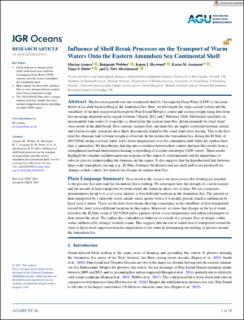| dc.contributor.author | Azaneu, Marina | |
| dc.contributor.author | Webber, Benjamin | |
| dc.contributor.author | Heywood, Karen J. | |
| dc.contributor.author | Assmann, Karen | |
| dc.contributor.author | Dotto, Tiago S. | |
| dc.contributor.author | Abrahamsen, E. Povl | |
| dc.date.accessioned | 2023-11-20T08:42:50Z | |
| dc.date.available | 2023-11-20T08:42:50Z | |
| dc.date.created | 2023-06-14T09:39:59Z | |
| dc.date.issued | 2023 | |
| dc.identifier.citation | Journal of Geophysical Research (JGR): Oceans. 2023, 128 (5), . | |
| dc.identifier.issn | 2169-9275 | |
| dc.identifier.uri | https://hdl.handle.net/11250/3103461 | |
| dc.description.abstract | The heat transported onto the continental shelf by Circumpolar Deep Water (CDW) is the main driver of ice shelf basal melting in the Amundsen Sea. Here, we investigate the slope current system and the variability of the heat transported through the Pine Island-Thwaites central and eastern troughs using data from five moorings deployed in the region between 5 March 2012 and 7 February 2016. Substantial variability on intermonthly time scales (3–4 months) is observed in the onshore heat flux, driven primarily by zonal wind stress north of the shelf break. Heat content, onshore flow, and heat flux are highly correlated between central and eastern troughs, which are most likely dynamically linked by the zonal wind stress forcing. This is the first time this dynamic link between troughs is observed. In the eastern the Amundsen Sea, during the El Niño of 2015/2016, strong eastward winds led to lower temperatures over the continental shelf while the onshore heat flux is intensified. We hypothesize that this anti-correlation between heat content and heat flux results from a strengthened eastward undercurrent leading to upwelling of a colder and deeper CDW variety. These results highlight the complex and heterogeneous response of this region to environmental and the importance of velocity data for understanding the dynamics in this region. It also suggests that the hypothesized link between large-scale atmospheric forcing (e.g., El Niño-Southern Oscillation) and ice-shelf melt is not produced via changes in heat content, but instead via changes in onshore heat flux. | |
| dc.language.iso | eng | |
| dc.title | Influence of Shelf Break Processes on the Transport of Warm Waters Onto the Eastern Amundsen Sea Continental Shelf | |
| dc.title.alternative | Influence of Shelf Break Processes on the Transport of Warm Waters Onto the Eastern Amundsen Sea Continental Shelf | |
| dc.type | Peer reviewed | |
| dc.type | Journal article | |
| dc.description.version | publishedVersion | |
| dc.source.pagenumber | 19 | |
| dc.source.volume | 128 | |
| dc.source.journal | Journal of Geophysical Research (JGR): Oceans | |
| dc.source.issue | 5 | |
| dc.identifier.doi | 10.1029/2022JC019535 | |
| dc.identifier.cristin | 2154327 | |
| cristin.ispublished | true | |
| cristin.fulltext | original | |
| cristin.qualitycode | 2 | |
